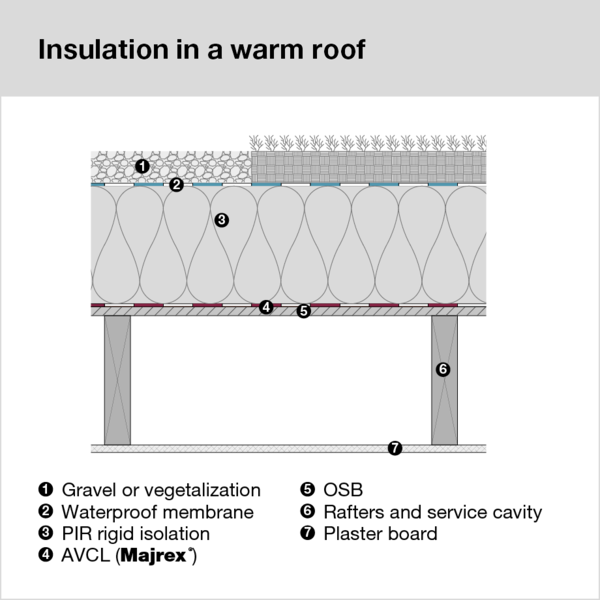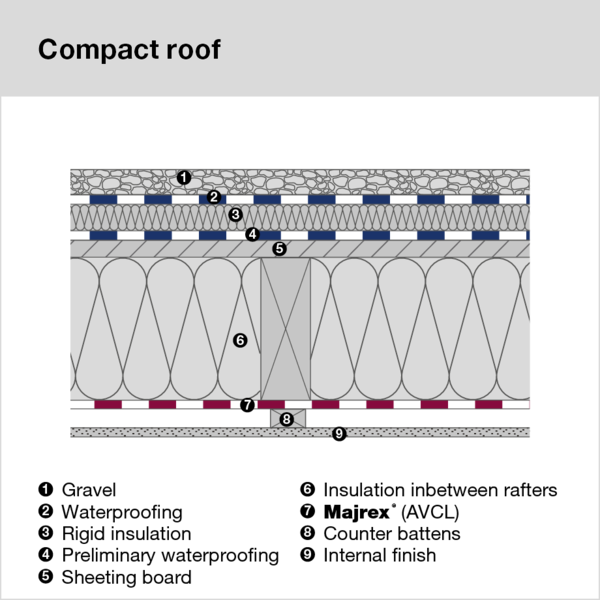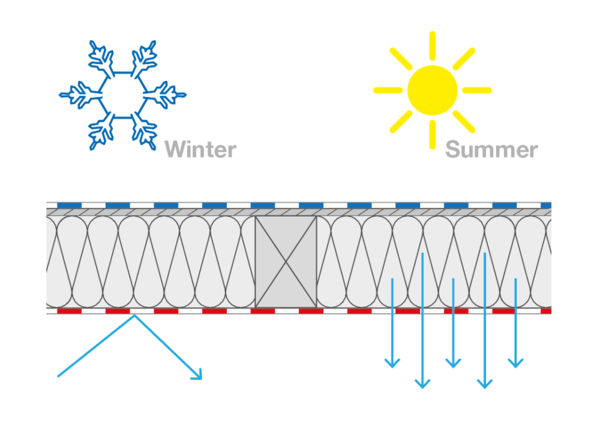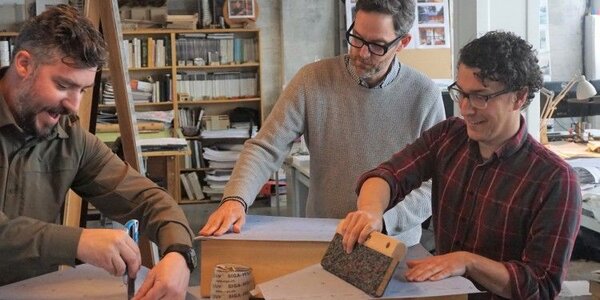You would like to deepen your knowledge about Majrex® and would like to try the product one to one?
Book now a CPD at your company!
I want to attend a CPD
Majrex® is an innovative air and vapour control layer that prevents condensation and boosts airtightness. Discover five life-saving benefits of using Majrex® in your building projects.
You may not have met Majrex® yet, but I think you’re going to get along.
Majrex® (pronounced “My-Rex”) is a sheet membrane that acts an air and vapour control layer; or AVCL for short. You may not think you even need a membrane. Or perhaps you do and have already nailed the product selection. But Majrex® has some unique properties. For example it is the only one-directional membrane available.
More importantly than any of this though, is that construction is a hard game. The risk of moisture damage is ever-present, even long after the job is done as a latent defect. Majrex® can stop you from finding yourself in a sticky situation.
Let’s look at some of the most risky types of construction, from a moisture perspective.
We know we have to design out risk, right? Trapped moisture causes all sorts of mischief;
But we can’t avoid moisture. It is everywhere in the building; during construction and afterwards. Therefore, we have to control its movement. An AVCL layer mediates the flow of moisture from the warm wet room to the cold dry exterior (or vice versa in Summer).
You can use many things as an AVCL, but some work better than others.
A Polythene sheet will completely prevent air movement. So, you might pass your airtightness target. But the sheet has also stopped moisture dead in its tracks. The moisture trapped in the fabric or generated in the room will manifest in some unpleasant way sooner or later.
Metal is a strong material, but it is also a very good conductor of heat. In a metal framed building, the risk of thermal bridging is much higher than otherwise. The metal can rust and fail. So, we need to take extra precaution.
Majrex® has a unique arrangement of layers that act as a one-way barrier for moisture. Moisture entering the insulation layer is mostly blocked. However, any moisture that inevitably enters the insulation can easily pass out and away. This means Majrex® can keep spaces dry that need to stay dry.
In metal building, where you cannot risk uncontrolled moisture build up, Majrex® will prevent this from happening.
Flat roofs have a poor reputation for short lifespan and early failure. It often happens around November time, and the cause is not what you might think it is.
The roof finish itself is necessarily impermeable to water. That is, after all, its job. But this is counter to a golden rule of safe construction:
Make sure the outer layers are less permeable to water vapour than the internal layers.
So, we have an unavoidable yet risky situation. Moisture that is in, or gets into, the fabric will try to go to outside. It will hit the cold & impermeable roof felt and immediately condense.
This happens all winter and all summer (especially at night). It can be masked by the summer heat, but when the weather turns cold & damp, around November time, water damage appears.
SIGA have found that 80% of the time the damage in a flat roof is caused in this way; not by leaks from outside, but by trapped moisture from inside the room.
By stopping moisture from entering the roof build up from inside, and yet able to let trapped moisture out, Majrex® resolves this situation. SIGA can show you how, and warranty it for you, too. That gives you peace of mind.
With a “Warm roof” construction, the insulation is located outside of the roof joists & is therefore more bulky & expensive.
SIGA are so confident of the performance, we can bend the rules a little. We’ve called it the” Compact roof” here:

RIGID insulation in a warm roof build-up

Because Majrex® is moisture-safe, it is located inside of the joists, and most of the insulation above the deck in a warm roof can now be placed between the joists – contact SIGA for advice here. This means you can have a roof which is not only better performing but also cheaper and slimmer to build (by about 20% overall; ask us for the figures).
When a building is tall, the chance of failure can be increased, and the impact of failure is much greater. The wind pressure is far greater, and you absolutely do not want to have to go back to it if it fails at a later date.
Moisture trapped in the fabric from construction or occupation can stay hidden for many years, only to manifest as a latent defect later on. It’s worth doing everything you can to avoid this happening.
Some membranes describe themselves as ‘smart’. This is an over-used adjective, but in this case it usually means that the behaviour is dependant on humidity. Smart membranes will allow more moisture to pass if it gets more humid, and less when it is dry. Makes sense, right?
But this can actually make matters worse! During construction the whole place is laden with moisture, you do not want the membrane to be open to moisture, as all that water goes straight into the wall and sits there.
To prevent a smart membrane wall from becoming water-laden in construction, you –could- cover-up the walls with plastic sheeting during the wet trades, and remove the sheet before dry-lining. But that would be a lot of hassle, and very time consuming.
Majrex® effectively does this for you, with no extra operation. During wet trades, it prevents the insulation from becoming loaded with damp. Once the building is in operation, any moisture that gets trapped can escape easily.
Moisture and heat flows are dynamic. As we said, the variable membrane responds to humidity levels, but its performance isn’t always right for the situation. What is a consistent truth is that we want moisture to leave the insulation (where it can escape to air) rather than enter the insulation. The Majrex® will always do this; dry or wet, winter or summer.

Controlled ventilation to extract the internal moisture
The vapour resistance (Sd value) at a medium relative humidity, in the direction entering the insulation is 15m ; leaving it just 5m. In other words moisture is 3 times more likely to leave the insulation than enter it. There is a humidity variation in the properties too, similar to other smart membranes, albeit the one-directionality is maintained. These properties have been verified by the technical university in Dresden & in the world patent. There’s more discussion on this in the linked article at the end of the blog.
So you might say Majrex® out-smarts the smart membrane. It’s a patented product that is the result of SIGA’s single minded focus on efficient buildings.
Basement walls are particularly tricky. Just like a flat roof the exterior layer, in this case the tanking, needs to be completely impermeable. So, we have introduced a risk. Basements are also wetter because of ground water.
If you are renovating a basement, your options are quite limited for controlling the risks. Majrex® is a dependable way to halt the moisture from the room from going outside, while at the same time letting any moisture in the fabric get out.
Don’t take our word for it. We can show you right now. There’s a neat science experiment you can watch on YouTube. A wet teabag is placed into an envelope of Majrex; one envelope is right way round so the moisture is allowed to escape. Yet the other envelope is turned inside out- so the moisture remains trapped.
From this you can see that the one-way properties really do work. Nearly time for a cuppa.
I think you get the idea by now; certain constructions introduce more risk. The way to manage that is by applying the right product.
A curtain wall is (or at least it should be) an impermeable external skin. If you are trying to achieve an airtight building, this creates risk.
A curtain wall building is bit like wearing a suit of armour and nothing else. It’s pretty good at keeping the rain off, but because the thin outer layer is impermeable, it is damp or draughty in the winter, yet still sweaty in the summer. That’s not a sensible way to dress, soldier.
When we dress, we know about adding a permeable layer of warmth next to the skin, AKA a wicking layer. An internal AVCL next to insulation does that job- keeps you warm and keeps you dry. The Majrex® allows moisture generated by the curtain walling to escape. That’s much better.
That’s it. You’re now intimate with Majrex. It might just get you out of a hole someday very soon.
Time to get the kettle on.
If you would like to go deeper here’s an article by the independent US technical Journal of Light Construction.

Book now a CPD at your company!
I want to attend a CPD
Bertie has practised building services engineering and sustainability consulting in the UK for 15 years. He is a certified PassivHaus planner. He is on a mission to help you deliver a high-quality building, one that does what it says on the tin.
Added to my cart